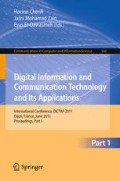Abstract
This paper presents alternative security methods based on DNA. From the alternative security methods available, a DNA algorithm was implemented using symmetric coding in BioJava and MatLab. As results, a comparison has been made between the performances of different standard symmetrical algorithms using dedicated applications. In addition to this, we also present an asymmetric key generation and DNA security algorithm. The asymmetric key generation algorithm starts from a password phrase. The asymmetric DNA algorithm proposes a mechanism which makes use of more encryption technologies. Therefore, it is more reliable and more powerful than the OTP DNA symmetric algorithm.
Access this chapter
Tax calculation will be finalised at checkout
Purchases are for personal use only
Preview
Unable to display preview. Download preview PDF.
References
Hook, D.: Beginning Cryptography with Java. Wrox Press (2005)
Kahn, D.: The codebrakers. McMillan, New York (1967)
Schena, M.: Microarray analysis. Wiley-Liss (July 2003)
Adleman, L.M.: Molecular computation of solution to combinatorial problems. Science 266, 1021–1024 (1994)
Schneier, B.: Applied cryptography: protocols, algorithms, and source code in C. John Wiley & Sons Inc., Chichester (1996)
Java Cryptography Architecture. Sun Microsystems (2011), http://java.sun.com/j2se/1.4.2/docs/guide/security/CryptoSpec.html
Genetics Home Reference. U.S. National Library of Medicine (2011), http://ghr.nlm.nih.gov/handbook/basics/dna
Hodorogea, T., Vaida, M.F.: Blood Analysis as Biometric Selection of Public Keys. In: 7 th International Carpathian Control Conference ICCC 2006, Ostrava – Beskydy, Czech Republic, May 29-31, pp. 675–678 (2006)
Gehani, A., LaBean, T., Reif, J.: DNA-Based Cryptography. DIMACS Series in Discrete Mathematics and Theoretical Computer Science (LNCS), vol. 54. Springer, Heidelberg (2004)
Tornea, O., Borda, M., Hodorogea, T., Vaida, M.-F.: Encryption System with Indexing DNA Chromosomes Cryptographic Algorithm. In: IASTED International Conference on Biomedical Engineering (BioMed 2010), Innsbruck, Austria, paper 680-099, February 15-18, pp. 12–15 (2010)
Wilson, R. K.: The sequence of Homo sapiens FOSMID clone ABC14-50190700J6, submitted to (2009), http://www.ncbi.nlm.nih.gov
DNA Alphabet. VSNS BioComputing Division (2011), http://www.techfak.uni-bielefeld.de/bcd/Curric/PrwAli/node7.html#SECTION00071000000000000000
Wagner, Neal R.: The Laws of Cryptography with Java Code. [PDF] (2003)
Schneier, B.: Description of a New Variable-Length Key, 64-Bit Block Cipher (Blowfish). In: Anderson, R. (ed.) FSE 1993. LNCS, vol. 809, Springer, Heidelberg (1994)
Amin, S.T., Saeb, M., El-Gindi, S.: A DNA-based Implementation of YAEA Encryption Algorithm. In: IASTED International Conference on Computational Intelligence, San Francisco, pp. 120–125 (2006)
BioJava (2011), http://java.sun.com/developer/technicalArticles/javaopensource/biojava/
Nobelis, N., Boudaoud, K., Riveill, M.: Une architecture pour le transfert électronique sécurisé de document, PhD Thesis, Equipe Rainbow, Laboratories I3S – CNRS, Sophia-Antipolis, France (2008)
Techateerawat, P.: A Review on Quantum Cryptography Technology. International Transaction Journal of Engineering, Management & Applied Sciences & Technologies 1, 35–41 (2010)
Vaida, M.-F., Terec, R., Tornea, O., Ligia, C., Vanea, A.: DNA Alternative Security, Advances in Intelligent Systems and Technologies. In: Proceedings ECIT 2010 – 6th European Conference on Intelligent Systems and Technologies, Iasi, Romania, October 07-09, pp. 1–4 (2010)
Holland, R.C.G., Down, T., Pocock, M., Prlić, A., Huen, D., James, K., Foisy, S., Dräger, A., Yates, A., Heuer, M., Schreiber, M.J.: BioJava: an Open-Source Framework for Bioinformatics. Bioinformatics (2008)
RSA Security Inc. Public-Key Cryptography Standards (PKCS) PKCS #5 v2.0: Password-Based Cryptography Standard (2000)
Author information
Authors and Affiliations
Editor information
Editors and Affiliations
Rights and permissions
Copyright information
© 2011 Springer-Verlag Berlin Heidelberg
About this paper
Cite this paper
Vaida, MF., Terec, R., Alboaie, L. (2011). Alternative DNA Security Using BioJava. In: Cherifi, H., Zain, J.M., El-Qawasmeh, E. (eds) Digital Information and Communication Technology and Its Applications. DICTAP 2011. Communications in Computer and Information Science, vol 166. Springer, Berlin, Heidelberg. https://doi.org/10.1007/978-3-642-21984-9_39
Download citation
DOI: https://doi.org/10.1007/978-3-642-21984-9_39
Publisher Name: Springer, Berlin, Heidelberg
Print ISBN: 978-3-642-21983-2
Online ISBN: 978-3-642-21984-9
eBook Packages: Computer ScienceComputer Science (R0)

